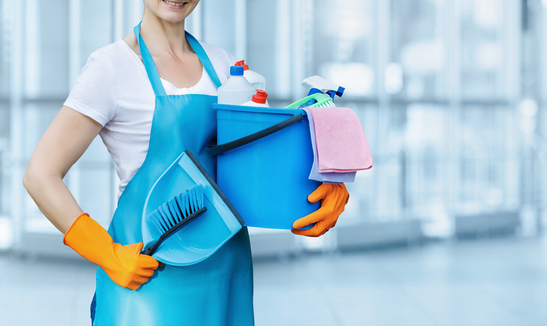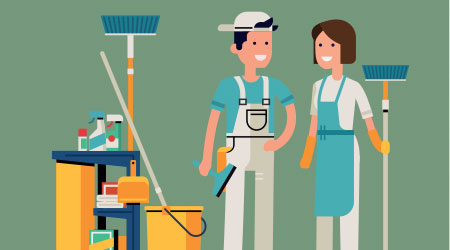The Best Guide to Everyday Cleaning: How to Scrub the Surfaces, Vacuum Carpets, and Clear Out Any Clutter
The Best Guide to Everyday Cleaning: How to Scrub the Surfaces, Vacuum Carpets, and Clear Out Any Clutter
Blog Article
Understanding the Requirement for Completely Sanitizing and Disinfecting Regularly Touched Surface Areas in High-Traffic Locations
In the world of public health and safety, the thorough sanitation and sanitization of often touched surfaces in high-traffic areas stand as critical actions in stopping the spread of hazardous virus. By discovering the various aspects of surface area disinfection, from the dangers connected with neglecting cleaning procedures to the effective methods that can be employed, a more clear understanding emerges of the vital function these techniques play in guarding public health and wellness.
Importance of Surface Area Disinfection
Emphasizing the detailed disinfection of high-traffic surface areas is crucial in keeping a sanitary setting and avoiding the spread of dangerous virus. High-touch surfaces such as door handles, light buttons, elevator switches, and kitchen counters function as breeding grounds for bacteria and infections. Normal sanitation of these surfaces is critical to minimize the risk of contamination and transmission of ailments.
By implementing a durable sanitation protocol, businesses and organizations can develop a more secure environment for clients, site visitors, and employees. Correct surface disinfection not just minimizes the spread of infectious illness yet also instills confidence in the tidiness and safety and security of the properties. This proactive method shows a dedication to wellness and wellness, which is especially vital in high-traffic locations where the possibility of direct exposure to virus is heightened.
Additionally, surface area sanitation plays a vital role in total infection control techniques. Incorporated with hand hygiene methods, putting on masks, and maintaining physical distancing, complete sanitation of high-touch surface areas forms an extensive protection versus the transmission of harmful microorganisms. Prioritizing surface sanitation is an essential component of a holistic strategy to wellness and safety and security in common spaces.
Threats of Disregarding Cleansing Practices
Ignoring complete sanitation of high-traffic surfaces considerably heightens the risk of bacterial and viral contamination, posturing a significant threat to the health and wellness of individuals frequenting these spaces. Failing to carry out appropriate cleaning methods can result in the buildup and spread of dangerous microorganisms, including microorganisms and viruses, on frequently touched surface areas such as doorknobs, handrails, elevator switches, and counter tops.

Furthermore, overlooking the significance of comprehensive cleansing not only endangers the wellness of people however additionally weakens initiatives to maintain a clean and hygienic setting. It is critical to acknowledge the significance of appropriate disinfection procedures in avoiding the spread of infections and guarding public health and wellness.
Reliable Disinfection Approaches
To maintain optimum cleanliness and minimize the threat of contamination on high-traffic surfaces, using effective disinfection methods is necessary. One of one of the most reliable and common disinfection approaches is using chemical disinfectants. These items can differ in strength and structure, with some targeting certain pathogens like germs or infections. It is crucial to comply with the maker's guidelines for proper dilution, get in touch with time, and air flow when making use of chemical disinfectants to ensure their efficiency - Clear Out Any Clutter.
An additional reliable approach is making use of UV-C light. UV-C light has actually been revealed to be efficient in killing a broad range of bacteria by disrupting their DNA structure, thus preventing them from replicating. It is important to use UV-C light properly, ensuring that the proper strength and exposure time are applied to attain the preferred disinfection outcomes.
Furthermore, utilizing vapor cleaning as a sanitation technique can be very blog here efficient, especially on surface areas that are heat-resistant. Steam can pass through porous surface areas and kill microorganisms, viruses, and various other pathogens successfully. When using heavy steam cleansing, it is very important to ensure that the surface area reaches the needed temperature level for an enough amount of time to assure appropriate sanitation.
Impact on Public Health And Wellness
The maintenance of high requirements of cleanliness and sanitation on high-traffic surfaces plays a critical function in guarding public health. Frequently touched surfaces in areas with high footfall, such as doorknobs, handrails, elevator buttons, and restroom facilities, serve as reproducing premises for harmful virus.
In high-traffic areas like airport terminals, institutions, medical facilities, and public transportation systems, the influence of extensive disinfection actions can not be underrated. Prioritizing the sanitization of regularly touched surface areas is a proactive strategy to advertising public health and boosting the security of individuals in common spaces.
Applying Regular Cleaning Methods
Promptly setting up and sticking to a constant schedule of cleaning procedures is paramount for preserving the cleanliness and security of high-traffic surface areas. Regular cleansing protocols are necessary in avoiding the build-up of germs and microorganisms on regularly touched surfaces, particularly in locations with high foot web traffic. By applying a methodical strategy to cleaning, organizations can successfully reduce the danger of condition transmission and create a much healthier environment for workers, consumers, and the general public.
To establish an efficient cleansing timetable, it is essential to determine high-traffic locations that call for frequent attention. These areas may consist of doorknobs, hand rails, lift switches, restroom facilities, and shared devices. Applying a routine cleaning program that targets these surface areas numerous times a day can considerably minimize the spread of unsafe bacteria and viruses.
Moreover, utilizing suitable cleaner and disinfectants is essential to making sure that surface areas are extensively sanitized. Regular training of cleaning staff on proper cleaning techniques and the significance of adherence to the cleaning schedule is also essential in keeping a sanitary setting. By focusing on regular cleansing methods, companies can advertise the health and wellness and wellness of individuals who interact with these high-traffic surface areas.

Conclusion
Finally, it is important to focus on thorough sanitation and sanitization of frequently touched surfaces in high-traffic areas to stop the spread of damaging microorganisms and preserve public health and wellness. Ignoring appropriate cleaning methods can enhance the danger of contamination and transmission of illness. By executing routine cleaning protocols and using effective sanitation approaches, we can develop informative post a much safer setting for everybody (Everyday cleaning). It is crucial to acknowledge the importance of maintaining tidy surface areas in high-traffic areas to ensure the well-being of the area.
In the realm of public wellness and safety, the thorough disinfection and sanitization of frequently touched surface areas in high-traffic areas stand as paramount procedures in avoiding the spread of harmful virus. By checking out the various elements of surface sanitation, from the dangers associated with ignoring cleaning methods to the efficient methods that can be used, a clearer understanding emerges of the crucial function these practices play in guarding public health and wellness.Additionally, employing vapor cleansing as a sanitation method can be very efficient, specifically on surface areas that are heat-resistant. When using heavy steam cleaning, it is important to make certain that the surface area reaches the required temperature level for a sufficient amount of time to guarantee correct sanitation.
In conclusion, it is important to focus on thorough sanitation and sanitization of often touched surface areas in high-traffic locations find to avoid the spread of dangerous virus and maintain public health.
Report this page